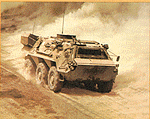
Because the incident and subsequent analysis involve the Fox reconnaissance vehicle and its MM-1 mobile mass spectrometer, an overview of the Fox and the MM-1 is presented here. Before the start of Operation Desert Storm, the German government gave the United States 60 Fuchs Nuclear, Biological, Chemical (NBC) Reconnaissance Vehicles. These 60 vehicles were modified for US forces. These modifications included the addition of the M43A1 chemical vapor detector as well as English language labels and English language software to the MM-1. The addition of the M43A1 augments the Fox MM-1 system by providing a credible detector of nerve agent vapor. The modified German vehicle became known to the US military as the XM93 Nuclear, Biological, and Chemical Reconnaissance Vehicle and was called the Fox vehicle. The Fox vehicle (Figure 5) is a six-wheeled light-armored vehicle designed primarily to detect, identify, and mark ground contamination of liquid chemical warfare agents.[75]
The primary chemical warfare agent detection system on the Fox vehicle consists of the MM-1 mobile mass spectrometer and an air/surface sampler. The MM-1 detects chemical warfare agents by analyzing the ionic activity of a sample that has been collected either by raising liquid samples from the ground to the retractable sampling probe by using silicon sampling wheels or by "sniffing" the surrounding air. The MM-1 continuously monitors samples passing through it, checking for the presence of chemical warfare agents identified on a pre-selected target list of 1 to 22 chemical compounds.[76]
Figure 5. Fox NBC Reconnaissance Vehicle
During the initial identification step, the MM-1 fragments each sample into a unique pattern of ions and then compares each four-ion "fingerprint" on the target list against the sample, searching for a match. If the MM-1 makes an initial match, and the ion intensities are above a specific level (unique for each agent), an alarm is sounded, displayed on the MM-1 operator’s screen, and printed on a paper tape.[77] This initial alarm, however, does not verify the presence of a chemical warfare agent since there are many chemical compounds that have the same or similar ions as those compounds on the chemical warfare agent target list. These other compounds can cause a false alarm for chemical warfare agents.[78]
Therefore, after an initial alert or alarm occurs, the MM-1 operator must perform a spectrum analysis[79] in order to increase the confidence of the detection of the presence of a chemical warfare agent. A spectrum analysis involves optimizing the MM-1 by lowering the temperature of the sample line from 180 degrees Celsius to 120 degrees Celsius for better ion separation, discontinuing use of the sample wheels, cleaning the sample probe to remove residual contamination, and lowering the probe to within 3 to 5 centimeters of the contamination, thereby allowing the MM-1 to acquire a better-prepared sample. With this better-prepared sample, the MM-1 searches its 60-compound chemical library of four-ion-peak fingerprints, compares them against this improved sample, and attempts to match the chemical warfare agent fingerprints with the sample.
It requires several minutes to collect a good sample and to obtain a good ion spectrum readout and analysis. This process is necessary to properly evaluate all of the ions contained in the sample for any suspected chemical warfare agent, and to assure that initial indications were not affected by contaminants from the battlefield (e.g., smoke, diesel exhaust, and oil). Although an MM-1 operator can produce a spectrum in other ways, this is the proper and most accurate method. The MM-1 operator should also print a tape which saves the details of the spectrum as a hard copy historical record.[80]
Should the properly performed spectrum acquisition procedure identify a chemical warfare agent, the MM-1 operator and the Fox commander can be confident that the agent is present. Conversely, if the spectrum analysis does not identify one of the chemical warfare agents contained in the MM-1 library, the MM-1 operator and the Fox commander can be confident that the chemical warfare agent that was displayed during the initial alarm is not present. Further analysis of the spectrum tape printout by a mass spectrometry expert comparing the spectrum results to an established database of compounds can increase the confidence level of the detection.[81] Additionally, the operators were taught to collect a specimen of the contamination (e.g., a soil sample) to further aid confirmation of the substance by thorough analysis in a laboratory. When the MM-1 can not match any of the compounds in the library to the sample, the MM-1 indicates "unknown" on the operator’s screen and the tape printout. Without the full spectrum and an analysis of the printout of the ion fragmentation pattern generated in the spectrum, the presence of a chemical warfare agent can not be confirmed.[82]
| First Page | Prev
Page | Next Page |